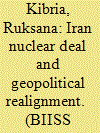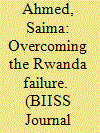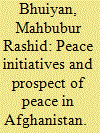|
|
|
Sort Order |
|
|
|
Items / Page
|
|
|
|
|
|
|
| Srl | Item |
| 1 |
ID:
133522


|
|
|
|
|
| Publication |
2014.
|
| Summary/Abstract |
The paper seeks to assess the growing strategic importance of the Bay of Bengal and how this signifies for Bangladesh's imperative to develop strong maritime capabilities. With the growing significance of the Bay of Bengal, both the littoral and the extra-littoral countries are reassessing their interests in this region and reformulating respective strategies to ensure optimum benefit in their favour. After the verdict by the International Tribunal for the Law of the Sea (ITLOS) in March 2012, Bangladesh is now able to establish its claim over a significant area in the Bay of Bengal. These emerging realities are driving Bangladesh to develop capabilities to project effective control over its maritime zone and to ensure sustainable utilisation of marine resources. To respond efficiently, Bangladesh government has undertaken various initiatives including modernisation of the Bangladesh Navy with an aim of establishing a three dimensional force. The paper, based on secondary literature, finds that there is a growing interest among the countries in the Bay of Bengal area leading to a competitive strategic atmosphere for countries like Bangladesh. The findings also suggest that Bangladesh's drive for maritime capability building is a timely and pragmatic step which requires further strengthening in the coming years. Besides, the paper also argues that Bangladesh needs to formulate a comprehensive maritime strategy, focusing on diverse sectors of capability building. Some key areas can include empowering the coast guard, resource exploration and exploitation capacities, maritime infrastructure development for connectivity and seaborne trade as well as well-coordinated maritime governance.
|
|
|
|
|
|
|
|
|
|
|
|
|
|
|
|
| 2 |
ID:
133523


|
|
|
|
|
| Publication |
2014.
|
| Summary/Abstract |
The November 2013 interim nuclear deal that was signed between the P5+1 and Iran is an epochal event, though, given the volatile situation, it may be too early to make a correct prognosis of its ramifications. For one thing, the nuclear deal could complicate the regional security environment by exacerbating Saudi-Iranian tension, though as such, it is not the source. Regardless of Saudi displeasure at the conclusion of the accord, Iran's ascendancy is amply clear, with its ambiguous nuclear status playing a strategic role. While the dominant narrative currently is the centrality of Shia-Sunni regional tension represented by Iran and Saudi Arabia, reality is far more intricate and multi-dimensional, requiring a more nuanced appreciation of their relationship, which suggests that, for the foreseeable future it would be in the US interest to have Saudi Arabia, off-setting Iran, but from a much weaker position, in a replay of the game of balance of power achieved through sustained geopolitical manipulation, and a smaller American foot-print. The goal of Tehran's nuclear brinksmanship is essentially ensuring its regional primacy, which accords with US interests, too. While the recent interim Iran deal apparently concerns the nuclear issue, it has far-reaching implications for the global energy market, which the relaxation of economic sanctions and the integration of Iran as a legitimate member of the international community is certain to affect. US-Iran normalisation of relations is quietly enhancing China's role, both economic and military, in the Gulf region, whose energy resources for the foreseeable future would continue to remain crucial for Beijing. More than a reconciliation between Washington and Tehran, the essence of a real paradigm shift would involve a Saudi-Iranian accommodation, and de facto Saudi acceptance of Iran's regional pre-eminence.
|
|
|
|
|
|
|
|
|
|
|
|
|
|
|
|
| 3 |
ID:
133525


|
|
|
|
|
| Publication |
2014.
|
| Summary/Abstract |
This paper discusses two norms that the United Nations led humanitarian interventions have been practicing since the 1990s: the Responsibility to Protect (R2P) and the Protection of Civilians. Both are very important agenda setters for future humanitarian interventions. The objective of this paper is to provide critical insights about how these two norms are applied on a limited scale during humanitarian interventions. The paper begins by reflecting on the failures of the United Nations in stopping and providing timely response during the genocide in Rwanda in 1993. It is argued that the causes of the Rwanda failure are the United Nations (UN), the United States (US), and the international community's inaction and unwillingness to spend resources to stop or prevent violent conflicts and/or gross violations of human rights in an impoverished region like Africa. These regions are of little value and pose little threat to the United States and other great powers. A human catastrophe in Rwanda or any other economically poor countries of the world seems distant to them, and would require long term engagement that the great powers think as would be a burden on them. They judge international prohibitions and take pivotal decisions of humanitarian interventions on a case by case basis when they think it is appropriate and necessary. Most often the great powers and/or the permanent members of the Security Council reflect their domestic decision makers' positions instead of the interests of justice, and often only uphold their national interests and other criteria. The paper then discusses the central challenges to operationalise the doctrine of Protection of Civilians - the very reason the concept of R2P was coined. Here the paper argues that the principle of R2P suffers from several important limitations when it aims at implementing the doctrine of Protection of Civilians. In the final section, the 2001 report on R2P of the International Commission on Intervention and State Sovereignty (ICISS), which was independently launched by the Canadian government, and the Outcome Document of the 2005 World Summit is analysed. It is suggested in the paper that many important recommendations of the ICISS were sidelined in the Outcome Document and this imposed limitations on the effectiveness of R2P's implementation. It is also argued that the primary causes of Rwanda failure were not reflected in these initiatives.
|
|
|
|
|
|
|
|
|
|
|
|
|
|
|
|
| 4 |
ID:
133524


|
|
|
|
|
| Publication |
2014.
|
| Summary/Abstract |
After the 9/11 attacks, the US-led coalition launched the global War on Terror, invaded Afghanistan and ousted the Taliban from power. The Karzai government came into power in January 2002. Nevertheless, the war is going on even after twelve years. Peace remains unachievable in Afghanistan while the war has spilled over into neighbouring Pakistan, given rise to several militant groups, continues to create instability in bordering countries. To end this bloody war, various parties have undertaken peace initiatives with the Taliban but the initiatives are facing growing uncertainty for various reasons e.g. the nature of the proposed withdrawal of NATO forces by 2014 is not clear, parties lack consensus, prioritise their individual interests and viewpoints, attach various conditions and change positions before and during peace talks etc. Pakistan, despite being a crucial actor in the current war in Afghanistan, has been experiencing its own security problems and much troubled relations with both Afghanistan and the NATO since joining the war. These have been negatively impacting peace initiatives. The country also remains deeply suspicious about another regional power India's growing involvement in and relations with Afghanistan. Besides the Afghan Taliban and Pakistani Taliban (TTP), there are several other militant groups active in Afghanistan and Pakistan, such as the Haqqani Network or the Hizb-e-Islami of Gulbuddin Hekmatyar (HIG) who pose significant threats. But they are seldom invited in peace talks and similarly, their positions or perspectives on peace process are hardly ever addressed or taken into consideration. Meanwhile, the Karzai government's relations with the US-led coalition are also not working well; this is visible from the increasing disagreements and mistrust plaguing their mutual ties. Owing to these reasons, a long-lasting peace seems unattainable for Afghanistan in near future.
|
|
|
|
|
|
|
|
|
|
|
|
|
|
|
|
| 5 |
ID:
133521


|
|
|
|
|
| Publication |
2014.
|
| Summary/Abstract |
Bangladesh and Myanmar share both land and maritime borders, and have age-old commercial and cultural ties. These two close neighbours have unlimited potentials in mutual cooperation in trade, connectivity and people to people contact. Both geostrategic and geoeconomic viewpoints justify the necessity of strong Bangladesh-Myanmar relations. Nevertheless, they have failed to best utilise their proximity and historical ties for economic and strategic gains. Since the establishment of the diplomatic tie in 1972, the relations have not always been smooth due to lack of political will especially from the Myanmar government, mutual misperceptions and suspicions. The Rohingya refugee issue, tensions in border and transnational crimes have been the key impediments to a meaningful bilateral relation. As consequences, many vital bilateral agreements and MoUs are pending. It is a reality that friends or allies may be changed but not neighbours. Therefore, the best interests of these close neighbours lie in exploring potential areas of cooperation and prosper together. This paper identifies several potential areas of mutual cooperation to explore and argues that for attaining a new height in Bangladesh-Myanmar relations, failure in resolving any hard issue such as the refugee issue should not be allowed to leave any negative impact on other prospective areas. Exploring the potential areas and trying to resolve the key disputes through various channels can be done simultaneously. For greater friendship, removing suspicions and opening up minds are imperative for these neighbours.
|
|
|
|
|
|
|
|
|
|
|
|
|
|
|
|
| 6 |
ID:
133519


|
|
|
|
|
| Summary/Abstract |
Bangladesh and Myanmar share both land and maritime borders, and have age-old commercial and cultural ties. These two close neighbours have unlimited potentials in mutual cooperation in trade, connectivity and people to people contact. Both geostrategic and geoeconomic viewpoints justify the necessity of strong Bangladesh-Myanmar relations. Nevertheless, they have failed to best utilise their proximity and historical ties for economic and strategic gains. Since the establishment of the diplomatic tie in 1972, the relations have not always been smooth due to lack of political will especially from the Myanmar government, mutual misperceptions and suspicions. The Rohingya refugee issue, tensions in border and transnational crimes have been the key impediments to a meaningful bilateral relation. As consequences, many vital bilateral agreements and MoUs are pending. It is a reality that friends or allies may be changed but not neighbours. Therefore, the best interests of these close neighbours lie in exploring potential areas of cooperation and prosper together. This paper identifies several potential areas of mutual cooperation to explore and argues that for attaining a new height in Bangladesh-Myanmar relations, failure in resolving any hard issue such as the refugee issue should not be allowed to leave any negative impact on other prospective areas. Exploring the potential areas and trying to resolve the key disputes through various channels can be done simultaneously. For greater friendship, removing suspicions and opening up minds are imperative for these neighbours.
|
|
|
|
|
|
|
|
|
|
|
|
|
|
|
|
| 7 |
ID:
133520


|
|
|
|
|
| Summary/Abstract |
Bangladesh and Myanmar share both land and maritime borders, and have age-old commercial and cultural ties. These two close neighbours have unlimited potentials in mutual cooperation in trade, connectivity and people to people contact. Both geostrategic and geoeconomic viewpoints justify the necessity of strong Bangladesh-Myanmar relations. Nevertheless, they have failed to best utilise their proximity and historical ties for economic and strategic gains. Since the establishment of the diplomatic tie in 1972, the relations have not always been smooth due to lack of political will especially from the Myanmar government, mutual misperceptions and suspicions. The Rohingya refugee issue, tensions in border and transnational crimes have been the key impediments to a meaningful bilateral relation. As consequences, many vital bilateral agreements and MoUs are pending. It is a reality that friends or allies may be changed but not neighbours. Therefore, the best interests of these close neighbours lie in exploring potential areas of cooperation and prosper together. This paper identifies several potential areas of mutual cooperation to explore and argues that for attaining a new height in Bangladesh-Myanmar relations, failure in resolving any hard issue such as the refugee issue should not be allowed to leave any negative impact on other prospective areas. Exploring the potential areas and trying to resolve the key disputes through various channels can be done simultaneously. For greater friendship, removing suspicions and opening up minds are imperative for these neighbours.
|
|
|
|
|
|
|
|
|
|
|
|
|
|
|
|
|
|
|
|
|